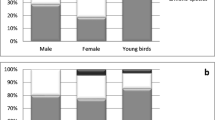Abstract
The potential for the transport and diffusion of some pathogenic microorganisms by migratory birds is of concern. Migratory birds may be involved in the dispersal of microorganisms and may play a role of mechanical and biological vectors. The efficiency of dispersal of pathogenic microorganisms depends on a wide range of biotic and abiotic factors that influence the survival or disappearance of a given agent in a geographical area. In the present study, 349 migratory birds were captured in four sites (Mazara del Vallo, Lampedusa, Ustica and Linosa), representing the main stop-over points during spring and autumnal migration, and analyzed for the presence of filamentous fungi. A total of 2,337 filamentous fungi were isolated from 216 birds and identified by a combined phenotypic-genotypic approach to species level. Twelve species were identified in the study, with Cladosporium cladosporioides, Alternaria alternata, and Aspergillus niger as the most abundant. The transport of these fungal species isolated in this study is of considerable importance because some of these species can create dangers to human health.

Similar content being viewed by others
References
Altschul SF, Madden TL, Schaffer AA, Zhang J, Zhang Z, Miller W, Lipman DJ (1997) Grapped BLAST and PSI-BLAST: a new generation of protein database search programs. Nucleic Acids Res 25:3389–3402
Barnett HL, Hunter BB (1998) Illustrated genera of imperfect fungi, edition 4. Spiral-bound press
Burton NHK, Rehfisch MM, Clark NA, Dodd SG (2006) Impacts of sudden winter habitat loss on the body condition and survival of redshank Tringa tetanus. J Appl Ecol 43:464–473
Cafarchia C, Camarda A, Romito D (2006) Occurrence of yeasts in cloacae of migratory birds. Mycopathologia 161:229–234
Domsch KH, Gams W, Anderson TH (2007) Compendium of soil fungi, second edition. APS Press, St Paul
Elfving K, Olsen B, Bergstrom S, Waldenstrom J, Lundkvist A, Anders S, Mejlon H, Nilsson K (2010) Dissemination of spotted fever rickettsia agents in Europe by migrating birds. PlosOne 5:1–5
Francesca N, Canale DE, Settanni L, Moschetti G (2012) Dissemination of wine-related yeasts by migratory birds. Environ Microbiol Rep 4:105–112
Gardes M, Bruns TD (1993) ITS primers with enhanced specificity for basidiomycetes: application to the identification of mycorrhizae and rusts. Mol Ecol 2:113–118
Goddard MR, Anfang N, Tang R, Gardner RC, Jun C (2010) A distinct population of Saccharomyces cerevisiae in New Zealand: evidence for local dispersal by insects and human-aided global dispersal in oak barrels. Environ Microbiol 12:63–73
Goymann W, Spina F, Ferri A, Fusani L (2010) Body fat influences departure from stopover sites in migratory birds: evidence from whole island telemetry. Biol Lett 6:478–481
Griessler K, Rodrigues I, Handl J, Hofstetter U (2010) Occurrence of mycotoxins in Southern Europe. World Mycotoxin J 3:301–309
Horner WE, Helbling A, Salvaggio JE, Lehrer SB (1995) Fungal allergens. Clin Microbiol Rev 8:161–179
Huang WY, Cai YZ, Surveswaran S, Hyde KD, Corke H, Sun M (2009) Molecular phylogenetic identification of endophytic fungi isolated from three Artemisia species. Fungal Divers 36:69–88
Hubalek Z (2004) An annotated checklist of pathogenic microorganisms associated with migratory birds. J Wildl Dis 40:639–659
Kaiser A (1993) A new multi-category classification of subcutaneous fat deposits of songbirds. J Field Ornithol 64:246–255
Kwon JH, Cheon MG, Kim J, Kwack YB (2011) Black rot of kiwifruit caused by Alternaria alternata in Korea. Plant Pathol J 27:298–305
Lòpez-Mendoza MC, Cespo-Sampere A, Martinez-Culebras PV (2009) Identification of Aspergillus tubingensis strains responsible for OTA contamination in grapes and wine based on the acyl transferase domain of a polyketide synthase gene. Int J Food Microbiol 44:2147–2152
Moreau RE (1961) Problems of Mediterranean-Saharan migration. Ibis 103a: 373–427
Moreau RE (1972) The Palaearctic-African bird migration systems. Academic Press, London
Moss MO (2002) Micotoxyn review 1. Aspergillus and penicillium. Mycologist 16:116–119
Musetti R, Polizzotto R, Vecchione A, Borselli S, Zulini L, D’Ambrosio M, di Toppi LS, Pertot I (2007) Antifungal activity of diketopiperazines extracted from Alternaria alternata against Plasmopara viticola: an ultrastructural study. Micron 38:643–650
Nuttall PA (1997) Hoste-parasite evolution. In: Clayton DH, Moore J (eds) Viruses, bacteria and fungi of birds. University Press, Oxford, pp 271–302
O’Donnell K, Cigelnik E, Nirenberg HI (1998) Molecular systematics and phylogeography of the Gibberella fujikuroi species complex. Mycologia 90:465–493
Omenn GS (2010) Evolution and public health. In: Ellison PT (ed) Harvard University, Cambridge, pp 1702–1709
Svensson L (1992) Identification guide to European passerines. British Trust for Ornithology, Stockholm
Tosi E, Fedrizzi B, Azzolini M, Finato F, Simonato B, Zapparoli G (2012) Effects of noble rot on must composition and aroma profile of Amarone wine produced by the traditional grape withering protocol. Food Chem 130:370–385
Tsiodras S, Kelesidis T, Kelesidis I, Bauchinger U, Falagas ME (2008) Human infections associated with wild birds. J Infect 56:83–98
Vu NT, Le TM, Duong AT (2008) Microbial diversity of traditional Vietnamese alcohol fermentation starters (banh men) as determined by PCR-mediated DGGE. Int J Food Microbiol 128:268–273
White TJ, Bruns T, Lee S, Taylor J (1990) PCR protocols: a guide to methods and applications. In: Innis MA, Gelfand DH, Sninsky JJ, White TJ (eds) Amplification and direct sequencing of fungal ribosomal RNA genes for phylogenetics. Academic Press, San Diego, pp 315–322
Acknowledgments
The authors are grateful to Prof. B. Massa, Dr. D. E. Canale, and Dr. P. Lucido for their help with analysis and interpretation of data. Dr. S. D’Angelo and the staff of Riserva Naturale Integrale Lago Preola and Gorghi Tondi (Mazara del Vallo, TP, Italy) are also thanked for their supervision during bird ringing.
Author information
Authors and Affiliations
Corresponding author
Rights and permissions
About this article
Cite this article
Alfonzo, A., Francesca, N., Sannino, C. et al. Filamentous Fungi Transported by Birds During Migration Across the Mediterranean Sea. Curr Microbiol 66, 236–242 (2013). https://doi.org/10.1007/s00284-012-0262-9
Received:
Accepted:
Published:
Issue Date:
DOI: https://doi.org/10.1007/s00284-012-0262-9




